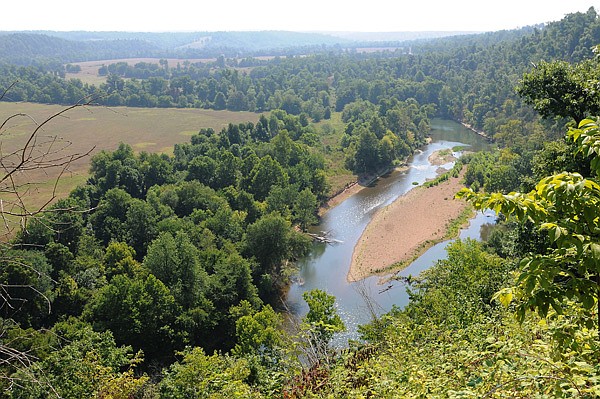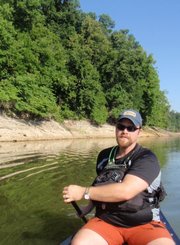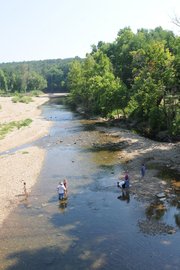Keep It Clean
GROUP FIGHTS FOR LAKE WATER QUALITY
Rain that falls far away from Beaver Lake may end up in the reservoir after flowing down tributaries such as the War Eagle River, shown here July 3. Protecting Beaver Lake, which is the region’s drinking water source, is the goal of the Beaver Watershed Alliance.
Thursday, July 12, 2012
GOSHEN — Rain that falls in Witter, West Fork or Winslow winds up in Beaver Lake, though each town is a far cry south of the reservoir.
Once that rain becomes one with the lake, it flows from tap-water clean from faucets in Northwest Arkansas and as far east as Harrison.
If you live in the region and aren’t on a well, your drinking water comes from Beaver Lake.
That’s something the Beaver Watershed Alliance wants more people to know in its quest to protect the lake and the land around it for drinking water and recreation.
Clean water is fuel that drives Northwest Arkansas’ economic motor. Without abundant clean water from Beaver Lake, business and industry and 250,000 residents wouldn’t be here today.
Those are words Jason Kindall, alliance director, and a growing number of volunteers say to anyone who will listen. The group jumps at the chance to speak to civic clubs, conservation organizations and school groups.
It’s not all talk and no action.
Work days include land cleanups.
People can keep the water-quality drum beating by signing up for the group’s newsletter. They can make donations to education eff orts and be good stewards of their property.
“What people do on their own land, in their yards and fi elds, affects the watershed,” Kindall said.
What’s a watershed? Not everyone knows, Kindall said. It’s all the land that drains water into a stream, river or lake.
It’s how that rain drop in Witter ends up in Beaver Lake, because Witter is in the Beaver Lake Watershed.
Let’s say that droplet falls on the highway in front of the tiny Witter post oftce. The drop finds its way into a ditch, then joins a fl ow of water on its way to the War Eagle River.
Our Witter droplet then fl ows for miles down the War Eagle, through Madison County anda slice of Benton County until the river enters Beaver Lake downstream from the War Eagle Mill.
It’s the same scenario on the White River. A rain drop that falls in distant Pettigrew travelsfor miles down the White River, past St. Paul and Elkins, until the White joins Beaver Lake east of Fayetteville.
On the other side of the coin, rain that falls in most of Rogers, Springdale and Fayetteville doesn’t flow into nearby Beaver Lake. Most moves west into the Illinois River and is carried into Oklahoma.
Arkansas 265 is a rough sort of continental divide. Rain that falls east of the highway flows to Beaver Lake. Rainfall to the west goes into the Illinois River.
ROLE FOR ALL
That lesson in Watershed 101 is part of the Beaver Watershed Alliance mission: To proactivelyenhance and sustain water quality in Beaver Lake and the integrity of its watershed.
Alan Fortenberry, chief executive officer of the Beaver Water District, said the alliance sprang from a strategy of the Northwest Arkansas Council to protect the lake.
Beaver Water District treats and supplies drinking water to the “big four” cities of the region and smaller towns as well. The alliance focuses on water quality.
“I see this group as helping to educate people on the best land practices,” Fortenberry said. “The thing they most want understood is every individual plays a role in protecting water quality.It may be a small role, but it’s a cumulative eff ect.”
Fortenberry said the quality of Beaver Lake water is good. It will never be pristine, he said. “It can’t be because there are people around it.”
Kindall said the alliance’s job is to maintain that quality through volunteer eff orts of watershed residents, not through regulation.
So, Mr. or Mrs. Landowner, what can you do as an individual? A lot, Kindall said.
One is to control erosion. If brown water fl ows through your yard or acreage, erosion is occurring and washing a prime pollutant - sediment - into the water supply.
One brown rivulet may not be much, but multiply that times thousands and the cumulative effect Fortenberry mentioned is obvious.
“Know your soil,” Kindall said.
Fertilizer may mean a nice green lawn or lush hay fi eld. Have the soil tested, Kindall said, and it may be it doesn’t require fertilizer at all. That benefits water quality and your billfold.
If a stream runs through your land, maintain a good filtering strip of vegetation and trees, a good riparian zone, from the water and up the stream bank for several yards.
A lush riparian zone fi lters pollutants naturally.
One thing urbanites can do is not let grass clippings blow into storm drains when they mow. Country folks should make sure their septic system works properly.
LET’S TALK
The Beaver Watershed Alliance began its education efforts in May 2011. Kindall is always eager to talk to any group about the alliance and tout Beaver Lake water quality through its website, social media, booklets andbrochures.
Consider this: Four water districts draw water from Beaver Lake and pipe treated water to Northwest Arkansas and beyond. Kindall fi gures around 430,000 people get their drinking water from Beaver Lake. That’s one ineight Arkansans.
On a hot summer day, Beaver Water District alone produces 80 million gallons of potable water.
Fortenberry said much more water is lost from Beaver Lake through evaporation than drawing it for water supply.
The lake level has dropped recently, but blame hot weather and blazing sun for that, not water treatment or hydropower production at Beaver Dam.
One thing Kindall noted is Beaver is the first lake in the chain of three on the main stem of the White River.
Keeping Beaver Lake clean keeps people downstream from pointing an accusing finger at Beaver Lake if water quality issues arise, as Oklahoma has done to Northwest Arkansas in water issues along the Illinois River.
“We can act now” to keep Beaver Lake clean, Kindall said, “or pay for it later.”
Acting now is what the Beaver Watershed Alliance is doing.
Outdoor, Pages 6 on 07/12/2012


